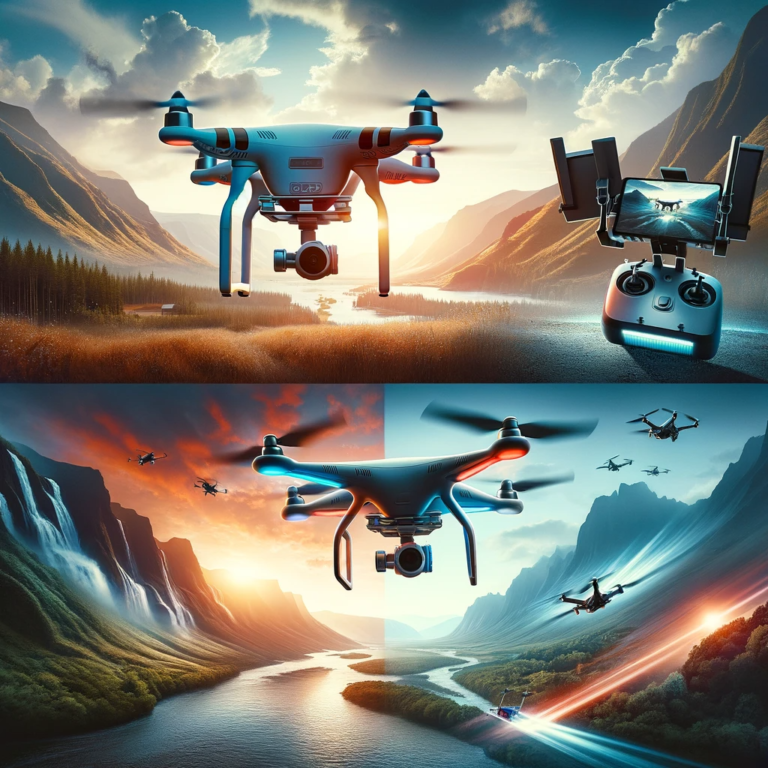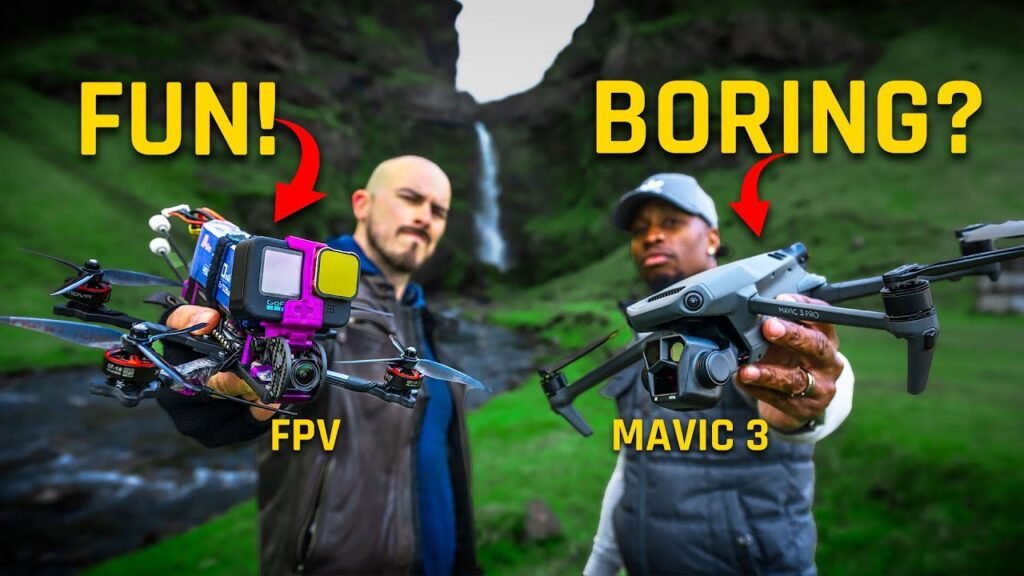
Are you passionate about capturing stunning footage from the sky? If so, you’ll want to check out Peter Lindgren’s video titled “best drone for cinematic footage? Regular Drone VS FPV Drone.” In this video, Peter and his friend venture to Iceland to test both regular consumer drones and FPV drones. The video provides a thorough comparison of the two types of drones, highlighting the pros and cons of each. Regular drones are praised for their ease of use, stability, and safety features, while FPV drones are commended for their ability to capture unique and mesmerizing footage. If you’re considering getting into drone cinematography, this video is a must-watch to help you make an informed decision on which type of drone is best for you.

This image is property of i.ytimg.com.
Introduction
When it comes to capturing footage from a unique perspective, drones are incredible tools. They allow you to take to the skies and capture stunning aerial shots of landscapes, events, and more. In this article, we will be exploring the differences between regular drones and FPV drones when it comes to capturing cinematic footage. We will discuss the ease of use, stability, safety features, camera options, and cost of each type of drone. To provide real-world examples, we will also share the results of testing these drones in the breathtaking landscapes of Iceland. So, if you’re interested in finding the best drone for cinematic footage, keep reading!
Regular Drones
Ease of Use
Regular consumer drones, such as the DJI Mavic 3 Pro, are known for their ease of use. They are designed to be user-friendly, even for beginners with no prior drone flying experience. With intuitive controls and helpful features like auto takeoff and landing, regular drones make it easy for anyone to start flying in no time. They often come with remote controllers that have clear and simple buttons and joysticks, making it a breeze for users to navigate and control the drone.
Stability
Stability is another key advantage of regular drones. Most consumer drones are equipped with advanced stabilization technology, such as gyroscopes and accelerometers, which help keep the drone steady in flight. This is particularly important when capturing cinematic footage, as any unwanted vibrations or shaking can ruin the visual quality of the footage. Regular drones are designed to provide smooth and steady flight, ensuring that your shots are clear and professional-looking.
Safety Features
Regular drones also excel in terms of safety features. Many consumer drones come with built-in obstacle avoidance technology, which uses sensors to detect and avoid potential obstacles in the drone’s flight path. This is especially crucial when flying in unfamiliar or crowded areas, as it prevents accidents and collisions. Additionally, regular drones often have GPS capabilities, allowing for precise positioning and reliable return-to-home functions.
Versatility in Camera Options
One of the major advantages of regular drones is the versatility they offer in terms of camera options. Many consumer drones, including the DJI Mavic 3 Pro, come with high-quality built-in cameras capable of shooting 4K video and capturing stunning still images. These cameras often offer a range of shooting modes and features, such as time-lapse, HDR, and manual control settings, giving users the ability to achieve their desired cinematic look. Some regular drones even have interchangeable lenses, allowing for further creative flexibility.
Complete Kit at a Lower Cost
Cost is an important consideration for many people when choosing a drone. Regular drones, such as the DJI Mavic 3 Pro, often come as complete kits that include everything you need to start flying and capturing cinematic footage. These kits typically include the drone itself, a controller, batteries, propellers, charging cables, and even a carrying case. Compared to FPV drones, regular drones generally offer a more affordable entry point into the world of aerial cinematography, providing great value for your investment.
FPV Drones
Unique and Mesmerizing Footage
While regular drones excel in ease of use and stability, FPV drones offer a whole different experience when it comes to capturing cinematic footage. FPV, which stands for First Person View, refers to the perspective in which the pilot sees the live video feed directly from the drone. This immersive experience allows for unique and mesmerizing footage that can’t be replicated with regular drones. FPV drones are known for their ability to capture dynamic and fast-paced shots that are visually thrilling and engaging.
Steep Learning Curve
One of the main challenges of flying FPV drones is the steep learning curve. Unlike regular drones, which are designed to be user-friendly, flying an FPV drone requires more skill and experience. FPV drones are typically controlled using a separate remote controller that requires precise hand-eye coordination and quick reactions. Pilots need to practice and develop their flying skills to maneuver the drone smoothly and confidently.
Requires More Skill to Fly
In addition to the learning curve, FPV drones demand more skill from the pilot while in flight. Since the camera on an FPV drone is fixed and doesn’t have the stabilization features found in regular drones, any movement or tilt of the drone will be reflected in the footage. This means that pilots need to master the art of flying smoothly and precisely to capture the desired cinematic shots. It takes practice and patience to become skilled at flying FPV drones and achieving professional-looking footage.
Additional Equipment and Cost
Another factor to consider when opting for FPV drones is the additional equipment and cost involved. Unlike regular drones that often come as complete kits, FPV drones usually require you to purchase additional components. This includes a remote controller specifically designed for FPV flying, batteries, a charger, and a high-quality action camera like a GoPro to capture the footage. These extra expenses can significantly increase the overall cost of getting into FPV flying.
Comparison
Now that we’ve explored the key features of both regular drones and FPV drones, let’s compare them side by side in various aspects.
Ease of Use
Regular drones take the lead in terms of ease of use. With their intuitive controls and user-friendly features, they are accessible to beginners and require minimal learning to start flying.
Stability
Regular drones are generally more stable in flight due to the advanced stabilization technology they incorporate. This stability ensures smooth and steady footage, even in challenging weather conditions.
Safety Features
Regular drones offer a wider range of safety features, including obstacle avoidance, GPS positioning, and return-to-home functions. These features provide added security and reduce the risk of accidents while flying.
Camera Options
Regular drones provide more versatility in terms of camera options. With built-in high-quality cameras and sometimes even interchangeable lenses, they offer a range of shooting modes and manual controls to achieve the desired cinematic look.
Cost
Regular drones, particularly complete kits like the DJI Mavic 3 Pro, provide a more affordable entry point into aerial cinematography. On the other hand, FPV drones require additional equipment and investment, making them more costly.
Testing in Iceland
To put both regular drones and FPV drones to the test, we embarked on a trip to Iceland. The beautiful landscapes and breathtaking scenery provided the perfect backdrop for capturing cinematic footage. We took both types of drones out in various locations, from mountains and waterfalls to coastal areas, to see how they performed in real-world conditions.
Results
Regular Drones Performance
During our testing in Iceland, regular drones, such as the DJI Mavic 3 Pro, proved to be reliable and user-friendly. They captured stunning aerial shots with ease, demonstrating smooth flight and stable footage. The high-quality built-in cameras offered excellent image and video quality, allowing us to achieve the desired cinematic look. The safety features, including obstacle avoidance and GPS positioning, provided peace of mind while flying in unfamiliar surroundings.
FPV Drones Performance
Flying FPV drones in Iceland provided a thrilling and immersive experience. The unique perspective offered by the FPV goggles gave us a sense of being in the pilot’s seat, capturing dynamic and exhilarating footage. However, it became evident that the learning curve and skill required for flying FPV drones were significantly higher. Achieving smooth and precise shots took practice and patience, and the lack of stabilization technology made it more challenging to capture steady footage. Additionally, the need for extra equipment, including a separate remote controller, batteries, charger, and action camera, added to the overall complexity and cost.
Conclusion
After extensive testing and comparison, it is clear that regular drones and FPV drones each have their own strengths and weaknesses when it comes to capturing cinematic footage. Regular drones are the go-to choice for beginners and those looking for ease of use, stability, and a complete kit at a lower cost. They offer a wide range of safety features and versatile camera options, making them accessible and reliable for capturing professional-looking footage. On the other hand, FPV drones provide a thrilling and unique experience for experienced pilots seeking a more immersive and dynamic perspective. While the learning curve is steep and additional equipment is required, the mesmerizing footage and the ability to push creative boundaries make FPV drones a compelling option for those willing to invest the time and effort.
In conclusion, the best drone for cinematic footage depends on your experience level, desired results, and budget. Regular drones are an excellent choice for beginners and those seeking a user-friendly approach. FPV drones offer a thrilling and immersive experience for experienced pilots who are willing to put in the time to master the skills needed. Whatever your choice, both types of drones have the potential to capture stunning and cinematic aerial footage that will wow viewers and elevate your storytelling.